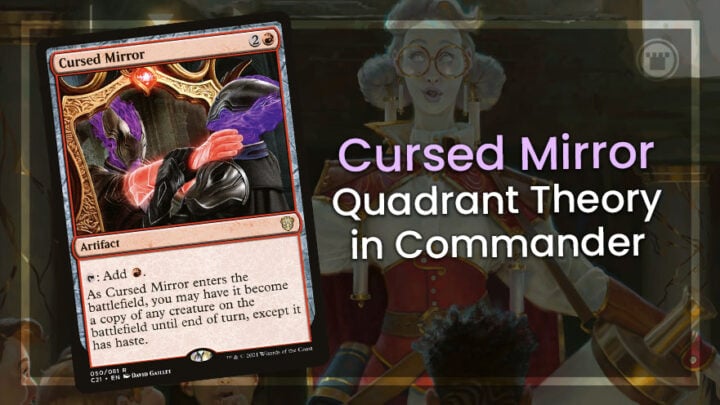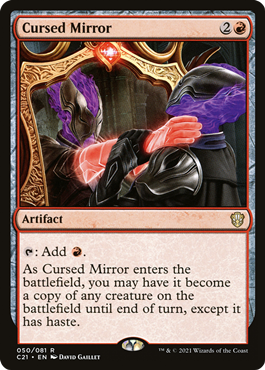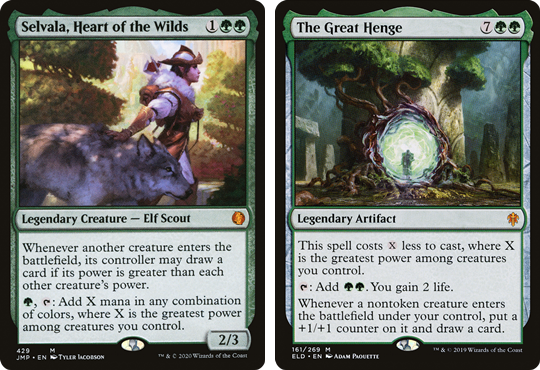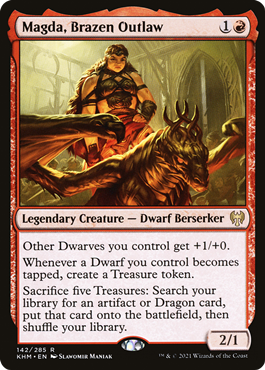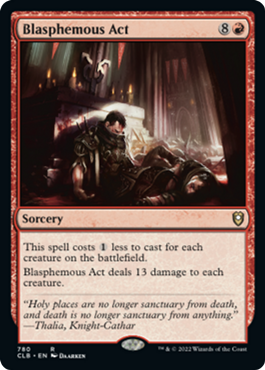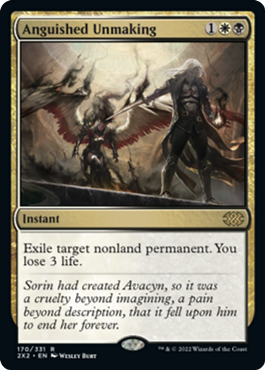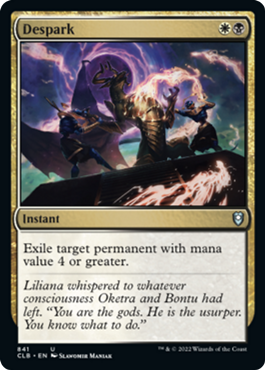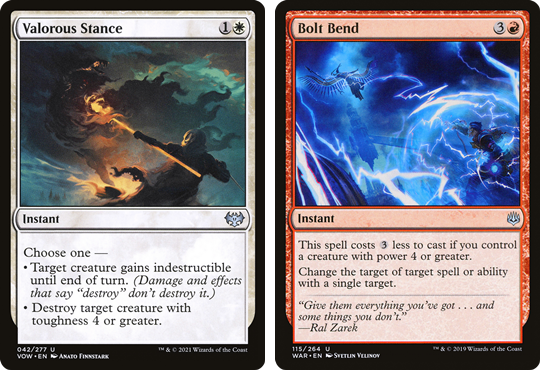Kristen explains why Cursed Mirror is one of her favorite cards by considering how it fares under Quadrant Theory
Quadrant Theory has been a great way to evaluate Magic cards since it originated with Brian Wong, a former co-host of the Limited Resources podcast. It looks at how good any given card is based on evaluation in four key scenarios:
- Developing
- Ahead
- At Parity
- Behind
The theory has plenty of buy-in from others, as Pro Magic players like Luis Scott Vargas and Marshall Sutcliffe explored the subject themselves. And while this theory has primarily been used to evaluate cards for Limited, it can be used to evaluate cards in other formats too — with a little tweaking of the scenarios and the parameters used to evaluate them.
Quadrant Theory in Commander
So how do we use Quadrant Theory for evaluating Commander cards? We can do this with a solid understanding of how Commander games develop.
However, before I begin, Quadrant Theory applies less well to cEDH. Competitive EDH is a different beast, and it plays closer to Legacy and Vintage than other Magic formats. This system is arguably less applicable to a game that has less defined early, mid, and late game stages — or one that generally involves less meaningful creature combat.
Now, let’s define our evaluation parameters more specifically within the context of Commander:
Developing is one of the easiest to transpose to Commander. The Developing stages of the game are when players are casting ramp spells, playing cantrips, putting down pieces of their engines and maybe playing their lower cost Commanders.
Since threat levels in EDH are so variable — much like the decks — the way to gate this stage of the game is best described as “the stage of the game where players don’t feel pressured to answer wins*, or to try and win.”
*This could also be replaced with “overwhelming advantage.”
Ahead is when a player clearly has the advantage. This state is most obvious when that player is the archenemy (when they are stomping the table and it isn’t even close), but it can sometimes be a little less obvious.
A good player will note who is ahead at the table, and it’s usually the player with the best mana situation, a good amount of cards available, reasonable blocks and some on-board interaction or lite-stax. They might be on the beatdown or have some parts of their combo assembled. They might even have a soft-lock on the table with cards like Dictate of Erebos or Sphere of Safety.
Notably, a player who isn’t “winning” might be seen as Ahead to a player Behind. But in actual fact, they are best described as At Parity with another player in good position.
At Parity is probably best described as the state of things after the first player to try and get ahead — or win — is stopped.
It’s when the dust settles after a board wipe. It’s when players are tentative about playing their hand out fully, but also keenly aware that the game hangs in a delicate balance.
Someone might try and win again soon, because players have enough mana to try. It can also be when a generous amount of single-target removal has surgically removed key pieces from each player during the developing stages, and nobody has pulled ahead to become the archenemy thus far.
Behind is pretty obvious. It’s when you’ve missed a land drop; when two players had Sol Ring and you didn’t. It’s when you’re being punished by your seat position by the tempo of the game, making you always too late to effect the board because of board wipes — or when you are in the uncomfortable position of having to cast a board wipe or other removal when you’d much rather try and scrape your way back to At Parity.
Cursed Mirror
This article was inspired, mostly, by my experiences playing with one of my favorite cards of the last couple of years: Cursed Mirror.
Three drop mana rocks enjoyed a renaissance of late, with many iterations on Manalith trying to offer you a reason to run them. While I personally think three mana rocks are fine (and even great, depending on the rock), there are those who prefer two mana ramp.
As a result, there’s a design push to try and sell players on playing these effects. In essence, this is power creep, but I would say it’s probably the good kind (if that’s even a thing).
Cursed Mirror, in my opinion, is close to the ceiling of what you can print on a three mana rock without creating something so absurdly powerful that it would be an auto-include in every deck. While I think Cursed Mirror is still an auto-include in a lot of red decks, I don’t think it’s as universally loved.
So, why do I love it?
Well, at its absolute floor, this is still a three mana rock. Three mana rocks aren’t unplayable, and you will sometimes just have to cast this for very little (or no) value to keep up with the ramping attempts from the other players at the table.
The thing is, even when you’re in the Developing stages of the game, Cursed Mirror will still have a reasonable creature to copy that will net you at least some value. You might get a Wood Elves, a Skyclave Apparition — hell, even the token from Fable of the Mirror Breaker would work. Our format revolves around creatures with enter-the-battlefield value, and I can count on one hand the amount of times I’ve cast this thing as a bad Manalith.
But when you’re Ahead, Cursed Mirror gives you a one-turn copy of one of the best critters on board. Now, generally speaking, you don’t want to draw ramp when you’re ahead (unless it contributes to your strategy, like in a landfall deck). But Cursed Mirror, on the other hand, gives you a second Sun Titan or Archon of Cruelty for a turn. That’s flat out disgusting for three mana.
When you’re Behind, you’ll often find yourself in a situation where you have to choose between building up your own board or interacting to stop other players from winning. This can feel especially punishing if you’re behind on mana and cards.
Cursed Mirror can really help you out here. It’s a three mana ramp spell that can conveniently copy something that either removes a key opposing piece or gives you some bit of advantage (either mana or cards).
What’s so exciting about this play is you can benefit from EtBs or attack triggers. And on cards that have both? You get both. I already mentioned Sun Titan, and I would say that it’s the Mardu sphere decks that want to build with Cursed Mirror in mind the most.
Meanwhile, when you’re At Parity, you’re often seeking a way to pull off a huge turn. To do that, you either need to play a one-sided board wipe or make a series of plays to both put you ahead and an opponent behind.
This often requires a big mana advantage — but Cursed Mirror solves this problem, too. Getting an extra copy of your best attacker (or one of the opponents) for a turn can enable a huge tempo swing. What’s more, copying a card like Nyxbloom Ancient only to then remove it with your extra mana — which I’ve done three times now, and feasted on my opponent’s salty tears with great satisfaction — is devastating.
Cursed Mirror does it all, folks. It’s the flagship card to explain Quadrant Theory in Commander. So, how do we use that knowledge to help us pick cards for decks?
Using Quadrant Theory in EDH Deckbuilding
Chances are, you’re probably already evaluating cards using Quadrant Theory when building your Commander decks — you just don’t realize it. In my article on playing more board wipes, I argue that you should nearly always be picking wipes that are either cheap or asymmetrical. Quadrant Theory is at play here, too, as the board wipes that fit in these categories are most playable at the four different stages of a game.
Let’s go over some prime EDH playable example cards that fit in each stage of the game.
Ramp cards in Commander are, generally speaking, either the most efficient or the most reliable — essentially Mana Crypt vs Cultivate. Ramp cards you want to play in the Developing stage of the game tend to rarely be good in all of the other categories, but that isn’t to say that cards can’t transcend this stage of the game.
Cursed Mirror is one example, Selvala, Heart of the Wilds is another. When she comes down later, she can make more mana and draw you cards. Anything that makes mana and draws cards is good in most quadrants, which is why The Great Henge is so expensive. Beyond that, my Miirym, Sentinel Wyrm Deck Tech article highlights a number of cards that are great at varying stages beyond developing — and it’s part of what makes the deck so powerful.
In order to bolster the potential of your ramp suite beyond the developing stages of the game, look at baking-in synergies. Look at how Harrow is a great choice when playing with Emeria Shepherd, but it’s also sweet in conjunction with Tireless Provisioner, which features in my Miirym list. Bursts of mana when you get to Parity are what can help you push ahead, and they can also give you a big turn when Behind. It’s why Dockside Extortionist is so darn good.
Other cards that remain relevant as a game progresses are cards like Magda, Brazen Outlaw. Sure, she’s close to broken when she comes down during the Developing stage, but if you have other treasure makers in the deck, she’s two mana to tutor something into play.
Out of nowhere, this can be devastating. It’s the kind of play you love to make when you’re Behind, the kind of play that breaks Parity and the kind of play that’s win-more when you’re Ahead.
Looking at a different kind of card, Blasphemous Act is the most played board wipe in the format, ignoring Cyclonic Rift. What sets it apart is that Blasphemous Act is a great draw when you’re Behind. Cyclonic Rift might well buy you a turn when behind, but you have to take the entire turn off — and that’s if you can cast it.
Ahead or At Parity, Blasphemous Act allows for some devilish plays. Because of the cost reduction, you get the rest of your mana to either make your board invulnerable (Teferi’s Protection, Boros Charm, etc) or to simply rebuild before anyone else.
Toxic Deluge, Vanquish the Horde, Tragic Arrogance and Austere Command are the next ones that tick the most boxes for Quadrant Theory. While cards like Hour of Revelation might excel more when Behind, it relies a lot more on comboing with other cards than Blasphemous Act. And, while the likes of Ruinous Ultimatum and Casualties of War are excellent while Ahead and At Parity, they can be harder to cast and convert to a win when Behind.
Crucially, Toxic Deluge remains the best board wipe for dealing with the Developing stages of a game, despite how bad it can be to pay life when sufficiently Behind.
The best removal in the format is instant speed and cheap. While Swords to Plowshares remains the best creature removal (for obvious reasons), the best removal to include in your decks beyond these cheap one or two mana creature removal spells is the most flexible removal. Adding options to instant speed and cheap gives the best results; Anguished Unmaking, Generous Gift and Chaos Warp.
Despark is also a great card, but when evaluated with Quadrant Theory, you can see that it falls short because it doesn’t do well in the Developing stage of the game. What’s interesting here is that won’t matter much to you if you’re playing a more relaxed and Casual style of Commander, but it absolutely will when you’re pushing things to the limits with high power gameplay.
At the same time, removal tends to matter less when you’re Ahead. It’s nice to have, but you’d most often rather draw into a win condition or a protection spell. That’s what makes a card like Valorous Stance relevant.
Keeping your best creature in a board wipe is great for two mana, and it satisfies the card being good when ahead condition. Like Despark, it’s sometimes less good in the Developing stages, but cards are getting bigger butts these days, so that comes up less often than you’d think. It still hits a Dryad of the Ilysian Grove early.
Similarly, Bolt Bend is good at both protecting you and punishing an opponent. While it’s also less likely to be good when Developing, it’s such a huge tempo swing that it excels in each other stage of a game.
END STEP
As you can see, Quadrant Theory is easily applicable to Commander, and learning about it can help you in your deck building. One thing to keep in mind is that cards that aren’t already clear staples are unlikely to be good in all Quadrants.
That’s because, generally speaking, cards that are good in all Quadrants tend to be few and far between. When you consider the current power creep of the format and what your deck is trying to do, you might find some cards tick three or even four Quadrants in a particular build.
Also, your Commander often dictates when a card is good just as much as the card itself, in a vacuum. Landfall decks benefit from playing Developing cards late on, and aggro decks can use a card like Valorous Stance to either protect the queen or to remove blockers, making them much better for certain strategies.
Some strategies seek to make Quadrant Theory irrelevant — decks full of hatebears or decks that want to Storm care much less about Quadrant Theory. But, in essence, Quadrant Theory is a theory born from evaluating Magic in one of its purest forms: booster draft. As soon as decks aim to break the mold and play magic in a different fashion, it tends to drop off.
That said, you can always use it to evaluate your deck’s “glue” — the ramp, interaction and other pieces that hold it together. But no matter how you use it, I hope it helps you build better, more capable decks in the process.

Kristen is Card Kingdom’s Head Writer and a member of the Commander Format Panel. Formerly a competitive Pokémon TCG grinder, she has been playing Magic since Shadows Over Innistrad, which in her opinion, was a great set to start with. When she’s not taking names with Equipment and Aggro strategies in Commander, she loves to play any form of Limited.

